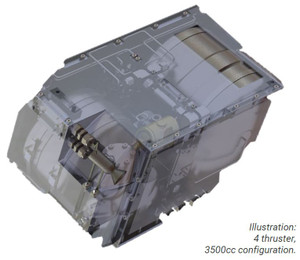
Click 'Get Pricing' to add this to a quote and access pricing information. After submission, get a response within 3 business days.
LMP-103S is an environmentally benign monopropellant based on the energetic material Ammonium DiNitramide (ADN). It offers a ≥30% density impulse improvement as compared to monopropellant hydrazine, while significantly reducing handling risk and costs, resulting in up to 72% cost reductions at launch site[1].
Propellant Blend:
- ADN: 63%
- Methanol: 18.4%
- Ammonia: 4.6%
- Water: 14%
Key Benefits:
- Higher Performance vs Hydrazine
- ISP >6%
- Density >24%
- Density Impulse >30%
- Reduced Personal and Environmental Hazards
- Simpler and Less Costly Handling an Transport
[1] Henry W. Mulkey, Green Propellant Loading Demonstration at U.S. Range (2016)
| Parameter | Value |
|---|---|
| Chemical Composition | 63.0% ADN, 18.4% Methanol, 4.6% Ammonia and 14.0% Water |
| Specific Impulse | ~253 s (theoretical) |
| Density | 1.24 kg/dm^3 (@ 20C) |
| Stability | Long-term storable (>20 years, STANAG 4582) |
| Carcinogenic | No |
| SCAPE required for handling | NO |
| Freezing Point | -90C (ADN saturation at -7C) |
| Normal Operation Temperatures | 10C to 50C |
| Exhaust gases | H2O, CO2, N2, H2, CO |
| Shipping | Class 1.4S, UN0481 (5L containers permitted on passenger aircraft) |




